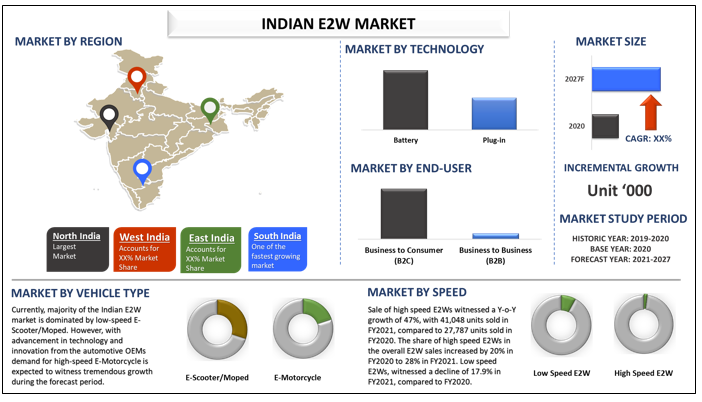Introduction
In the dynamic landscape of Indian mobility, the India Electric Two-Wheeler (E2W) market is poised for an extraordinary surge, projected to witness an unprecedented 72% Compound Annual Growth Rate (CAGR) from 2021 to 2027. Anticipating a monumental sales volume of 3,675.8 thousand units by 2027, the sector faces a pivotal moment in transforming the commuting experience in India.
Breaking Barriers: Overcoming High Initial Costs
A significant hurdle to the widespread adoption of electric vehicles in India has been the high initial cost. However, recent strategic moves, including the restructuring of the FAME-II scheme by the Indian government, have paved the way for change. Incentives for E2Ws have seen a substantial increase, climbing from INR 10,000/kWh to INR 15,000/kWh. This boost is anticipated to fuel both demand and adoption of electric vehicles, effectively bridging the pricing gap between E2Ws and their conventional counterparts.
FAME-II Initiative: Transforming Affordability
The FAME-II initiative has played a pivotal role in reshaping the landscape. By aligning incentives, the program has successfully brought down the price of E2Ws, making them more competitive with Internal Combustion Engine (ICE) two-wheelers. This strategic maneuver is set to drive accelerated growth in the electric mobility sector.
Access Sample PDF Here- https://univdatos.com/get-a-free-sample-form-php/?product_id=13045
Future Disruption: A Glimpse Beyond 2023
Looking ahead, the E2W sector is poised for significant disruption post-2023. The anticipated decline in battery costs to US$100/kWh (INR 7,625.25/kWh) is a game-changer. This shift is expected to make E2Ws even more economically viable, catalyzing a surge in adoption driven by factors such as rising fuel prices, decreasing battery costs, and substantial investments from local battery manufacturers.
Market Dynamics: Unveiling Trends and Shifts
E-Scooter/Moped Dominance
In the realm of vehicle types, the E-Scooter/Moped segment currently reigns supreme, constituting the majority of the Indian E2W market. However, with continuous technological advancements and innovations from automotive Original Equipment Manufacturers (OEMs), there is a significant anticipated shift towards the high-speed E-Motorcycle segment during the forecast period.
The Need for Speed: High-Speed E2Ws on the Horizon
Segmented by speed, low-speed E2Ws, primarily in the form of E-Scooter/Mopeds with speeds up to 25 KMPH, currently dominate the market. However, a seismic shift is expected by 2025, with the demand for high-speed E-Motorcycles projected to skyrocket. The fiscal year 2021 witnessed a remarkable 47% Year-on-Year growth in high-speed E2W sales, with 41,048 units sold compared to 27,787 units in FY2020.
Technological Landscape: Battery E2Ws Lead the Pack
In the technological arena, battery-powered E2Ws currently outpace plug-in models. The burgeoning demand for battery E2Ws, coupled with falling battery prices, is leveling the playing field, making electric bikes increasingly comparable to their petrol counterparts in terms of both upfront and operating costs.
End-User Dynamics: B2B Gaining Momentum
While Business to Consumer (B2C) currently dominates the market, a noticeable trend is the increasing adoption of E2Ws by businesses. Shifting fleets to E2Ws to leverage better economics is expected to propel the Business to Business (B2B) segment to witness high growth during the forecast period.
Regional Resonance: South India’s E2W Adoption Surge
Analyzing regional demand, South India emerges as a hotspot for E2W adoption, fueled by a strong government push to increase Electric Vehicle (EV) penetration. Incentives under the FAME-II scheme, along with waived registration fees and road tax in major states, contribute to the region’s exponential growth. The post-lockdown surge is attributed to a combination of central- and state-level policy measures, increasing consumer awareness, and the economic benefits of E2Ws.
Browse Research Methodology, Report Description and Table of Content- https://univdatos.com/report/india-e2w-market
Key Players Driving the Revolution
In this transformative journey, key players like Hero Electric, Okinawa, Ather Energy, and Ola Electric Mobility are at the forefront. Their contributions to the E2W space are instrumental in shaping a sustainable and efficient future of mobility in India.
Conclusion: Navigating the Future of Commuting
As India steers towards a greener and more sustainable future, the E2W market stands as a beacon of change. The convergence of favorable policies, technological innovations, and strategic investments positions electric two-wheelers as the driving force in the future of Indian commuting.
Contact us:
UnivDatos Market Insights (UMI)
Email: [email protected]
Ph: +91 7838604911


